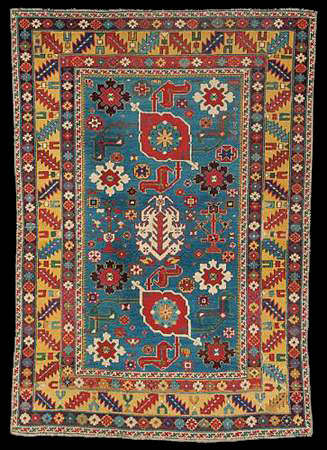|
Although its condition and brilliant colors give it a relatively new
appearance, this well-preserved rug is an early example of its type, known
as "Karagashli". Its high quality wool, vivid dyes, and fine weave are
representative of the best output of the Kuba district in the early 19th
century. Its age is suggested both by its quality and by the spacious and
fluidly drawn design of the field which in later Karagashli rugs tended to
become stiffer and more squared-off. The floral design elements are derived
from 18th-century blossom carpets of the eastern Caucasus, which descended
from earlier Southern Azerbaijani (NW Iran) carpets.
Formerly in the Rudnick Collection, it was published by
Bailey et al., "Through the Collectors Eye" (Providence 1991, pl.21) and was
sold at Sotheby’s in New York in December 1999 HALI 109, p.153). It is one
of the best of its type on the basis of colour, drawing, condition, wool
quality, complexity, and fineness of weave. Very precisely drawn, it has
intense, harmonious colours with three red dyes, including abrashed dark
purple as a guard border background. The ivory palmette, an escapee from
Chinese art, is intricately drawn. Later examples – with synthetic dyes,
which make age determination fairly simple – omit the palmette(s), while the
ogival forms are almost turned into rectangles. A comparison with pl.108 in
Ulrich Schürmann’s, Caucasian Rugs (1965), in which the design is
incompletely rendered, is instructive.
..Rugs with this design were woven all over the
Caucasus. ‘Karagashli’ is a Kerimov-sourced village name, said by many
writers about Caucasian rugs to be on the Daghestan border, near the Caspian
Sea (wrong). But rugs allegedly woven in that area have substantially
different patterns and structure from these two. Something’s not right.
However, there is a town named Qaragashli west of Baku, but whether it is
the source of either of these rugs is unknown. An educated guess is that
anything as finely woven as the second rug could well have come from near an
urban centre such as Baku. There are so many anomalies and contradictions in
the study of older Caucasian rugs that one can, at this point, only
appreciate them for their art value, and hope that some day they can be
placed accurately in a matrix of Azerbaijani material culture.
SIZE: 55 x 39 1/4 in. (139.7 x 99.7 cm.)
WARP: wool, z4s; ivory
WEFT: wool, Z3S x 2; ivory
PILE: wool, Z2S, symmetrical knots slightly pulled to the left and straight,
h. 10.5, v. n, 115.5 k/sq. in. (~180 000 knots per square meter); ivory,
dark brown, dark red, red, gold, yellow, green, green-blue, dark blue, blue,
light blue, dark purple, purple
ENDS: cut
SIDES: cut, modern overcast

|


